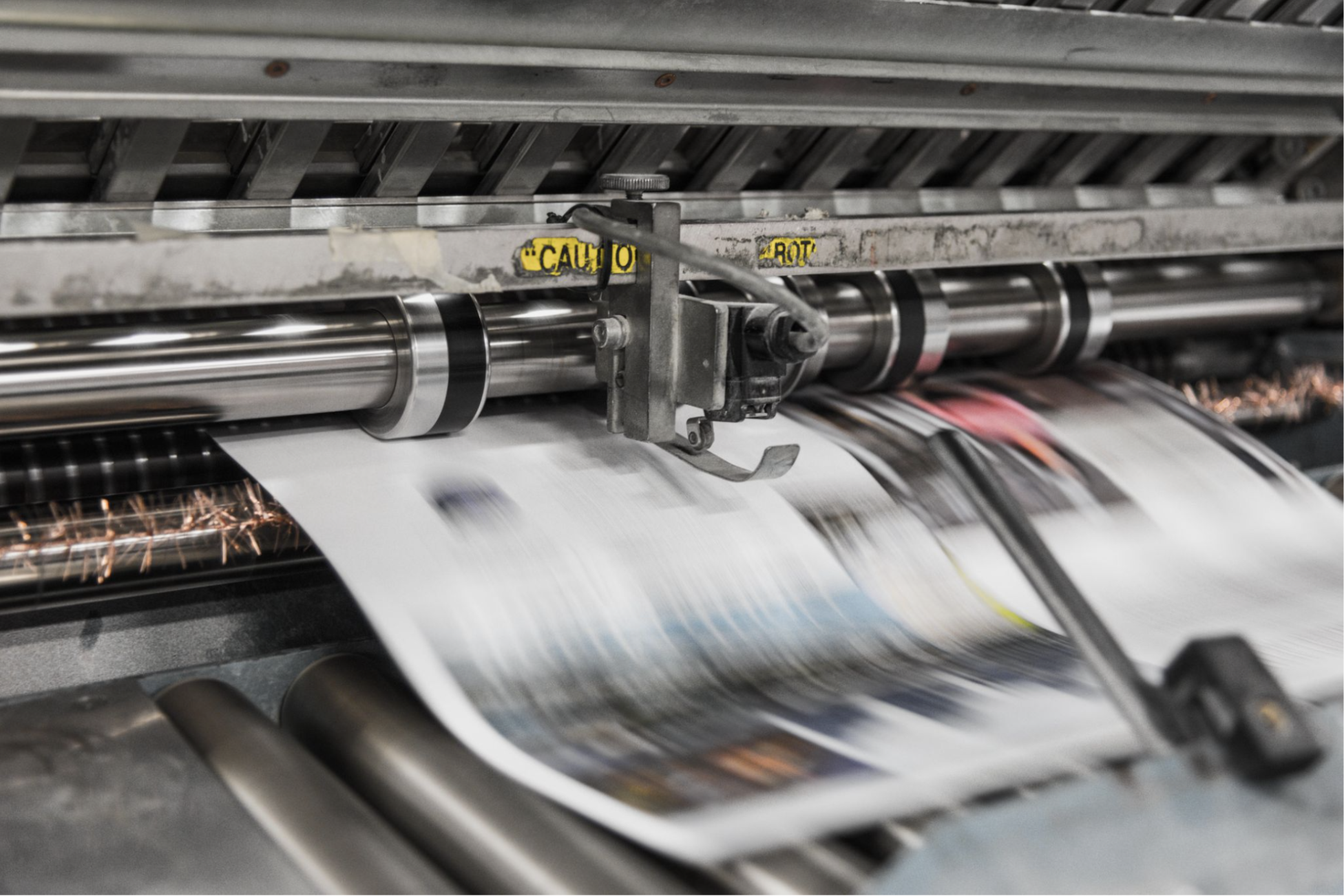Re-targeting in a recession. How can Direct Mail help you achieve more through sending less?
Leave your details below and we'll send you a copy of this Whitepaper.
Outsource your direct mail marketing
Why should you outsource your print /direct mail marketing?
Why use Automated Direct Mail in the first place?
Automated direct mail is a powerful tool for businesses looking to reach their target audience in a highly targeted and efficient way. This technology allows businesses to use data and algorithms to automatically select and send direct mail pieces to specific individuals based on their demographics, behaviour, and interests.
Effective automated direct mail campaigns can significantly increase response rates for direct mail marketing. Marketers can ensure that their direct mail pieces are reaching the right people at the right time, resulting in increased conversions and a higher ROI, by using data to target specific individuals. Additionally, the ability to monitor and assess the success of these marketing campaigns offers insightful data into what is effective and ineffective, enabling businesses to continuously enhance their direct mail initiatives. Wasted marketing efforts disappear with successful automated direct mail campaigns./span>
Another advantage of automated direct mail is that it allows businesses to easily target specific segments of their audience, such as new customers or high-value customers. By using data to identify these segments, businesses can create personalised direct mail pieces that are tailored to their needs and interests, which increases the chances of conversion. Automated direct mail also allows businesses to automate many aspects of their direct mail campaigns, making it a time-efficient and cost-effective solution.
Overall, automated direct mail is a valuable tool for businesses looking to increase the efficiency and effectiveness of their marketing efforts. It offers a powerful combination of targeting and automation that can help businesses reach their target audience more effectively and improve the ROI of their marketing campaigns.

Cost of Printing in-house
Printing automated direct mail in-house may seem like a cost-effective solution for businesses, but it can actually be quite costly in the long run. One of the main expenses associated with in-house printing is the cost of the equipment and supplies needed to produce high-quality direct mail pieces. This includes printers, ink, paper, and other materials. Additionally, businesses will also need to invest in software and technology to create and execute their automated direct mail campaigns, which can add up quickly.
Another cost to consider is the labour required to print and assemble the direct mail pieces. This includes the time and resources needed to design, print, and assemble the pieces, as well as the cost of any additional labour required for addressing and mailing the pieces. These costs can add up quickly, especially for businesses with large mailing lists or multiple campaigns. Furthermore, printing in-house may not always ensure the best quality of print and materials, which can impact the effectiveness of the campaign.
While printing automated direct mail in-house may seem like a cost-effective solution, it can actually be quite expensive in the long run. Businesses should carefully consider the costs associated with in-house printing and weigh them against the potential benefits before making a decision. Outsourcing to a professional direct mail printing service may be a more cost-effective option, as they can provide businesses with access to the latest technology, equipment and skilled labour, which can help to ensure high-quality, professional-looking direct mail pieces.
Expertise in Automated Direct Mail
Outsourcing the printing of direct mail marketing to an external provider can provide businesses with the expertise of a specialised printing company. One of the main advantages of this is the ability to take advantage of the professional knowledge and experience of the printing company. This includes the ability to produce high-quality, professional-looking direct mail pieces that are tailored to the specific needs of the business. They will also have experience in creating direct mail pieces that are effective in reaching and engaging the target audience.
Additionally, outsourced printing providers are experts in the field of direct mail printing, and will have a deep understanding of the best practices and techniques for printing and mailing out direct mail pieces. This can include knowledge of the most effective printing methods, paper types, and mailing techniques that can help to ensure that the direct mail pieces are delivered to the intended recipients in the best condition possible. They can also provide expert guidance on how to personalise and customise direct mail pieces to increase the chances of conversion.
Outsourcing printing to a specialised provider can bring a wealth of expertise to a business, which can help to ensure that their direct mail marketing campaigns are successful. It can also free up valuable time and resources for the business to focus on other aspects of their operations. Businesses should consider outsourcing printing as a cost-effective and efficient solution for their direct mail marketing efforts, as well as to gain the expertise of a specialised provider.
Advantages of an external partner
Outsourcing the printing of direct mail marketing to an external provider can provide businesses with a number of benefits. One of the main advantages is access to the latest technology and equipment. Professional printing services invest heavily in the latest printing technology and equipment, which means that businesses can be assured that their direct mail pieces will be produced to the highest quality standards. This can help to ensure that the direct mail marketing campaign is more effective and ultimately results in a better return on investment.
Another benefit of outsourcing the printing of direct mail marketing is the ability to take advantage of the expertise and experience of the printing company. Professional printing services employ skilled and experienced staff who have the knowledge and experience to produce high-quality, professional-looking direct mail pieces that are tailored to the specific needs of the business. This can help to ensure that the direct mail pieces are effective in reaching and engaging the target audience. Furthermore, outsourcing the printing can also free up valuable time and resources for the business to focus on other aspects of their operations.
Outsourcing the printing of direct mail marketing to an external provider can provide businesses with access to the latest technology, equipment, and skilled labour, which can help to ensure high-quality, professional-looking direct mail pieces. It can also free up valuable time and resources for the business and provide expert guidance for the campaign. Businesses should consider outsourcing printing as a cost-effective and efficient solution for their direct mail marketing efforts.
Paperplanes proposition
Paperplanes offers so much more than just the printing of Automated Direct Mail. A combination of expertise and thoughtful strategising allows us to offer our clients a variety of Mail Marketing Campaigns. Including abandoned basket, Winback and next-best purchase campaigns, boasting these stats:
- Topline Conversion
-
-
- 9.3% Topline conversion
-
- Abandoned basket conversions
-
-
- 40% Stronger with mail
- 9.3% of Baskets recovered
-
- Winback performance
-
-
- 3.2% of Lost customers were won back
-
- Page views
-
-
- 25% more pages viewed
-
- Average Basket Value
-
-
- 30% stronger basket value
-
- Incentive Conversion
-
-
- 15.5% of customers converted from Incentive based offers
-
- CPA
-
-
- CPA level of £9
-
- Uplift on Key Titles
-
-
- 68% uplift to Hearst’s key feature titles.
-
- Uplift in conversion
-
- 50% Sales uplift
Additionally offering our clients in-depth catchups explaining the performance of the campaigns we are running. Providing additional statistics specific to Automated Direct Mail and recommending next steps forward. Providing a full package and a transparent 360 view to all Paperplanes clients.
Sources:
https://www.ebcgroup.co.uk/wp-content/uploads/2020/05/outsourcing_vs_in-house_printing.pdf
https://www.resourcecentre.org.uk/printing/equipment-prices/
Setting and hitting your personal and Business & Marketing goals
Setting and hitting your personal and business goals
Personal Development & Business Development
As we start a New Year setting personal and business objectives are always top of mind.
Overlap
Sometimes personal and business development can overlap and personal development can strongly aid in the goal of business development. Picking up a new skill such as learning to edit videos is a personal development goal that also can be transferred into a business skill. Taking newly gained knowledge and video editing capabilities and creating marketing content benefits you personally as well as the business.
Mental health and well-being goals can also contribute towards personal and business growth. Choosing to begin meditation is a great example. The benefits of meditation are seemingly endless, decreasing stress and blood pressure levels, bringing clarity to the mind, reducing anxiety and reducing pain. This can lead to better decision-making and productivity in the office, potentially habits such as waking up earlier and having more consistent energy levels throughout the day.
Goal setting
Setting a clear goal is one of the most crucial steps to success. In regards to business development setting objectives and goals is a great way to keep yourself accountable and on track. Having an established endpoint with checkpoints along the way is going to make the process much easier. A great example from a business perspective would be setting revenue and sales targets.
Not hitting monthly or weekly targets is a good way to track if you are keeping up to date with youre plans or there isn’t enough engagement to achieve the goal. Ensuring the goal is S.M.A.R.T. is going to make getting there easier.
Business resolutions
As the New Year has begun now is a great time to reflect on your business and marketing efforts and set some resolutions for the coming year.
Consider creating a content calendar to plan out your content marketing in advance and stay consistent.
Building your email list and using email marketing can also be a great way to nurture relationships with customers and leads (but of course direct mail will be more effective :)).
Improving your website, increasing your online presence, and focusing on customer experience are all important steps towards success.
By setting and working towards these goals, you can improve your business and marketing efforts and achieve greater success in the new year.
Marketing objectives
As we look ahead to the new year, it’s important for businesses to set clear marketing goals that align with their overall strategy and objectives. Some common goals for businesses may include increasing brand awareness, driving website traffic, boosting sales, and improving customer engagement. To achieve these goals, businesses may consider a variety of tactics such as social media campaigns, email marketing, influencer partnerships, and targeted advertising.
Another aspect businesses should consider as a goal for the coming year is understanding the changing consumer behaviour and preferences. With the ongoing pandemic, many consumers have shifted their shopping habits, looking for contactless and more sustainable options. Businesses that can adapt to these changes and tailor their marketing strategies accordingly are more likely to be successful.
Smart Investing
Investing in marketing is crucial for any business that wants to grow and succeed in today’s competitive marketplace. A well-crafted and executed marketing strategy can help you increase brand awareness, attract new customers, boost sales, and differentiate your business from the competition. It can also help you build long-term relationships with your customers and retain their loyalty.
One of the key benefits of investing in marketing is that it can help you reach and connect with your target audience. With the right marketing tactics, you can effectively communicate the unique value of your products or services, and generate interest and engagement among your target consumers. A smart investment in marketing can also help you establish your brand as a leader in your industry, and gain a competitive advantage over your rivals.
However, it’s important to note that not all marketing investments are created equal. While it may be tempting to throw a lot of money at the latest marketing trends or channels, it’s important to be strategic and selective about where you invest your resources. A smart marketing investment is one that is aligned with your business goals, targets your ideal customers, and can be tracked and measured for return on investment.
Automated Direct Mail
Paperplanes offer an alternative to traditional methods of digital and physical marketing. By incorporating elements of digital and physical marketing Paperplanes provides an extremely cost-effective customer acquisition and retention strategy. Automated Direct Mail marketing provides customers with appropriately timed, hyper-personalised and relevant marketing content right at their front door.
Achieving these statistics with clients:
- Topline Conversion
-
-
- 9.3% Topline conversion
-
- Abandoned basket conversions
-
-
- 40% Stronger with mail
- 9.3% of Baskets recovered
-
- Page views
-
-
- 25% more pages viewed
-
- Average Basket Value
-
-
- 30% stronger basket value
-
- Incentive Conversion
-
- 15.5% of customers converted from Incentive based offers
Achieve all your marketing goals this year with the help of Paperplanes Automated direct mail. An environmentally friendly and cost-effective way to reach your customers.
Sources:
https://www.tonyrobbins.com/how-to-focus/meditation-for-business-success/
https://www.statista.com/chart/26578/uk-new-years-resolutions-for-2022-gcs/
PDM and optimising Customer Experience
Why and what makes a customer experience optimal?
Customer experience is everything. All engagements, touchpoints and journeys the prospect takes from the first moment they interact with your brand to the moment they are a paying customer using your product or service need to be seamless, enjoyable and hassle-free. Having a negative experience may not only turn away a prospect or customer but can also have a detrimental effect on future business through harming brand image, negative reviews, poor word-of-mouth marketing and blame sharing on social media. This blog will explore the value and measurements of having a positive customer experience (CX).
Measures of good Customer Experience
Google reviews, Yelp, Trust Pilot, Feefo and many other apps and programmes have been designed to help consumers make informed decisions when it comes to spending their money on products and services. This makes the customer experience even more valuable in 2022 than ever before. Consumers will read reviews and look at ratings before making a decision. Offering a poor customer experience will lead to worse reviews and hence lower conversion rates due to poor ratings.
Some factor which separates poor or average customer experience from a high-quality customer experience is making the consumer feel like they are more than just a transaction to the company, making them feel special. There are a few key concepts to consider when trying to make a consumer feel special.
- Making the consumer aware that the transactions are mutually beneficial
- The consumer is helping your business achieve its mission
- The Business is offering the consumer service or product they desire
- The journey the consumer embarks on has to have positive value for the consumer
- This can be done by sending thank you note to the customer or sending a follow-up E-mail after purchasing
- Rewarding loyal customers with discounts and offers
- Demonstrating to the consumers that their feedback has been received and taken into account or even implemented
PWC have actually outlined four key factors that contribute to a customer's overall experience with a brand and what helps makes it positive. These can be defined as
- Efficiency: build on this
- The whole experience should only take the time that the consumers intend to spend.
- There shouldn’t be delays and long delivery wait times without warning
- The E-commerce platform should be optimised for an appropriate number of users
- The whole experience should only take the time that the consumers intend to spend.
- Convenience: build on this
- Customers should be able to access the products, product details and other company information which the customer
- Relevant products are promoted to the consumers
- Website design offers the most relevant pages to the consumer on the landing page
- Customers should be able to access the products, product details and other company information which the customer
- Friendly service: build on this
- Employees should be able to assist consumers with any questions, quickly with politeness
- Important to establish a genuine connection with the consumer
- Exchange chat messages or emails with customers in a polite and brand-appropriate manner
- Employees should be able to assist consumers with any questions, quickly with politeness
- Easy payment:
- Payment options should be varied and the consumer shouldn’t have to prepare to pay via a select few methods.
- Accepting foreign currency and digital payment options
- No unexpected charges and costs
- Payment plans for expensive products (offering payment flexibility)
- Payment options should be varied and the consumer shouldn’t have to prepare to pay via a select few methods.

Consumers want an experience which won’t take up a large portion of their time whilst also having friendly and insightful conversations with the employees or sales platform.
E-commerce's role in positive customer experience
Customer experiences can easily extend into e-commerce and online shopping. Providing a positive experience for consumers across any channel can build loyal lifetime customers. With e-commerce shopping becoming the most prominent method of purchasing products it's an ideal time to optimise the customer experience.
Platform
Optimising your customer experience will require optimisation of the purchasing platform which the customers use. Simple tweaks can be made to optimise the ease of use for your consumers. Star with an easy-to-use landing page which will have all frequently used tabs and buttons clearly outlined for users. Additionally, consumers should be offered employee live chat if the company is providing a service rather than a tangible product. With knowledgeable and friendly service being among the important factors in customer satisfaction it would be ideal to have employees that are able to assist customers through live chat if possible.
Furthermore, Hubspot focused its resources on writing a blog on optimising your landing page and website for consumers. E-commerce platforms should prioritise convenience and ease of payment. An intuitive user-friendly design in regard to payment and product alterations is going to improve a consumer's experience (S. Chambers, 2021). Choosing the size, colour or material of their chosen product should be simple to do and ideally all on one screen. For services being able to have a calendar to choose a select time on the same page as payment would convenience the customer. Making payment flexible and simple should also be prioritised, allowing the consumers to pay securely and in as many ways as possible to ensure that there aren’t inconveniences to consumers.
Story
Another positive aspect of the e-commerce customer journey is that it provides a measurable way of identifying how customers are acquired. Providing an explainer video describing the service or process or production can attract consumers and help them build a bond with your company.
Social enterprises specifically benefit from telling their story in explainer videos, advertising campaigns and across their landing page and website. Once a consumer has an understanding of where the product came from or where the money they plan to spend is going they could be convinced to make the purchase they intended—selecting an appropriate narrative that will keep consumers interested and not seem artificial or forced upon them.
Positive customer experiences reduce wasted marketing spending
Customer retention and customer acquisition is part of the marketing department's responsibilities. It’s important to associate these two concepts with customer experience. Getting an innovative gripping and relevant piece of marketing is going to kick-start a customer's experience with a firm in a very positive way. Whilst retaining customers through relevant incentives and smartly chosen next-best purchase marketing will aid in customers having on overall greater lifetime satisfaction, making them more likely to market said product or service via word of mouth.
Physical
PaperPlanes programmatic direct mail marketing is an excellent way to keep high levels of customer retention and improve the consumer experience. Direct mail marketing is a great way to connect with customers in crucial periods which can lead to consumer conversions.
Mailing consumers when they have recently made a purchase and suggesting their next best purchase to follow, reminding consumers that they abandoned an online basket (and bringing them back with an incentive) and even mailing consumers who have not purchased in a long while or who might’ve unsubscribed from a service. Garner excellent results such as
- 300% more likely to return
- 50% more time spent browsing pages
- ROAS of £11 for every £1
- 9.3% Topline conversion
- 40% Stronger with mail
- 9.3% of Baskets recovered
- 3.2% of Lost customers were won back
Paperplanes could be your solution to improving customer experiences through your direct marketing channel. To learn more about how integrating programmatic direct mail can improve your customer experience throughout their lifecycle read our dedicated blog: https://paperplanes.co.uk/customer-lifecycle-pdm/
Get in touch with the button below to learn how paper planes can greatly improve your customer experience and provide your brand with more attention & retention.
Sources
https://marketinginsidergroup.com/marketing-strategy/marketing-trends/
https://blog.hubspot.com/service/customer-experience-optimization
Why is Personalisation so crucial for Christmas Marketing?
How are personalised Christmas letters and cards significant?
Writing Christmas letters is a yearly tradition for many people across the world and specifically in the UK. 900 Million Christmas cards are sent yearly with each household sending an average of 16 Christmas cards. In 2022 despite e-mail, text and social media becoming the most common mediums of communication, Christmas cards continue to be relevant and widely used. The Royal Mail still continues the tradition of writing Christmas letters to Santa, encouraging children across the UK to write him a letter during the Christmas season. Writing to loved ones and family during Christmas is a UK tradition and there’s no better way to do that than physically with a Christmas card.
Elements of a Christmas letter
An important element of any Christmas letter is the personalisation that each letter or card will have. Christmas cards are usually dedicated to an individual or to a specific group/family. The message contained in the letter is personalised to the receiver in more ways than just containing their name.
Christmas cards are unique in the number of different purposes and outcomes that they can have. Some of the most common and effective purposes include:
- Rekindling old or lost friendship
-
-
- Reaching out in a thoughtful and personal way to reconnect with a lost contact
-
- Communicating with close family or friends
-
-
- Letting family and friends know they’re in someone's thoughts and that they’re appreciated
-
- Promoting a product or service
-
- Write to your most loyal customers and make them feel appreciated with a personalised Christmas card or offer
The final crucial component of a successful Christmas card is making it personal to the recipient.. Just like the lapsing customer who typically visits your ecommerce website but hasn't recently it can sometimes be a while before we properly catch up with friends and family. A personalised message making them know you care and think about them is always better than a generic festive greeting or no personalisation at all.l
Carry over to Marketing
A personal handwritten and thoughtful Christmas letter is something that anyone would want to receive, so why shouldn’t your consumers? Christmas letters are all about spreading positive thoughts and enjoying the festive period. It’s the time of year for relaxation and enjoying the fruits of your labour. Consumers will be looking to buy presents for Christmas as well as New Years gifts. However, this could prove to be a slight challenge in 2022.

Source: Link
With no positive increase in Christmas spending plans, there is going to be more competition for the attention of consumers and likely an increase in marketing costs and spending. In addition, it seems as though overall spending during the Christmas season is going to be down from the previous year.

Consumers are not only spending less on gifts also less across the board on all Christmas activities. Travel has taken a decline alongside leisure activities affecting spending on food and drink in restaurants. While the Christmas season might see less consumer spending this will make effective targeted marketing even more important. There will be more competition this Christmas season than last year making it all the more crucial to wow your audience and doing so through sending less which is what smart utilisation of data can allow
Holiday Habits (Time at home)
Most people across the UK have time off during this period and likely all the way through to New Year. This means there is more time for consumers to be exposed to marketing. It also means there is more time to be spent on screens and on e-commerce websites shopping. Especially since it’s also an important time for buying gifts.
Power of personalisation
Studies have shown that there is a potential for a 30-50% higher response rate for personalised marketing, with other benefits such as a boost in consumer loyalty and confidence. This Christmas your marketing plan should be focused and personalisation to every customer. The trend of personalisation during Christmas has spread to possibly the most iconic Christmas brand Coca-Cola. The company promises to host a digital gift card service with recorded messages to send to loved ones, additionally producing personalisable drink bottles to purchase across their eCommerce platform to send as gifts.
In the spirit of writing and sending your Christmas letter all marketing during the holiday season should be personalised. Ideally, it should also be well thought out and memorable. It should be appropriately timed. It should feel wanted and welcomed by a consumer.
Digital
Marketing online is a common practice around Christmas. As most people are uploading photos of their time off and browsing other profiles online traffic increases. This leads to more potential exposure for advertising across social media. Video campaigns, banner ads and Emails are all great ways to connect with consumers during Christmas. Email has proven to be very effective during Christmas with consumers spending more when purchasing through email.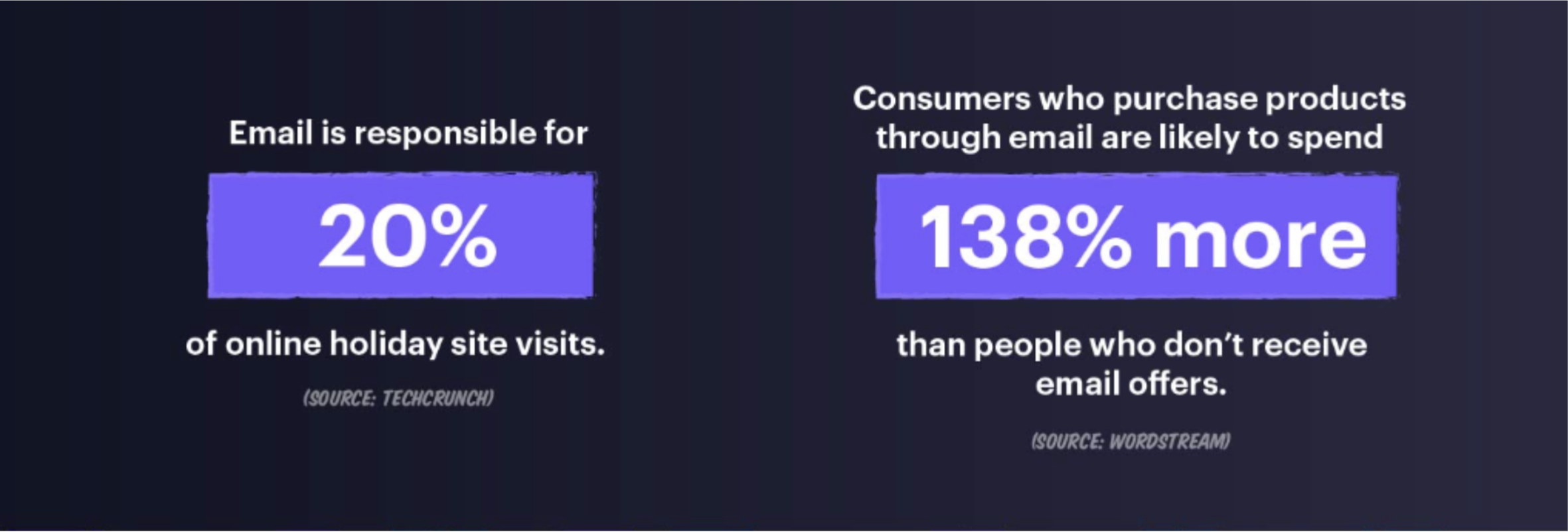
There is a negative to the increase in digital marketing during Christmas and that is the pricing. With 2023 looking to be the first year of economic recession marketing budgets will likely begin getting reduced. Prices for premium ad space only increase during Christmas therefore spending significantly on digital marketing might not yield positive results. Especially due to the competitive nature of online ad space as well as the often over-reliance on email marketing. An economical and more efficient solution would be Paperplanes Automated Direct Mail.
Automated Direct Mail
The spirit of Christmas cards and letters is carried on by Paperplanes’ automated direct mail service. Much like Christmas letters, Paperplanes sends personalised mail to consumers via a physical medium. Sending marketing messages at optimal conversion times to maximise the returns on each piece of mail sent. Sending your audience personalised mail to recover abandoned baskets and win back lost customers is smart automated personalisation in action. Direct mail has the advantage of being extra visible during the holiday period. Mail can sit at home on a coffee table or desk for weeks, being seen on a daily. Paperplanes Automated Direct Mail is also capable of achieving impressive results such as:
- Page views
-
-
- 25% more pages viewed
-
- Average Basket Value
-
-
- 30% stronger basket value
-
- Incentive Conversion
-
-
- 15.5% of customers converted from Incentive based offers
-
- CPA
-
-
- CPA level of £9
-
- Uplift on Key Titles
-
-
- 68% uplift to Hearst’s key feature titles.
-
- Uplift in conversion
-
- 50% Sales uplift
This Christmas and New Year adopt Automated Direct Mail into your marketing strategy and achieve all your New Year marketing resolutions.
Sources
https://www.newsletter.co.uk/lifestyle/christmas/who-received-the-first-christmas-card-3494764
https://www.royalmail.com/christmas/letters-to-santa
https://epica.com/blogs/articles-by-epica/benefits-handwriting-10-amazing-truths
https://www.finder.com/uk/christmas-shopping-statistics
https://www.marketingweek.com/coca-cola-promises-most-personalised-christmas-campaign/
How has GDPR affected Marketing & Data collection?
GDPR in Automated Direct Mail Mythbuster
The GDPR
The General Data Protection Regulations (GDPR) was a set of legislation passed by the EU affecting the EU economic zone. The GDPR standardised data protection laws in order to help consumers hold power over their personal data in the fast-evolving digital economy we are living in. The 7 core principles the UK GDPR believes in are:
(ICO.org, 2022)
- Lawfulness, fairness and transparency
- Purpose limitation
- Data minimisation
- Accuracy
- Storage limitation
- Integrity and confidentiality (security)
- Accountability
These 7 principles are outlined at the very beginning of the GDPR legislation. Those living in the EU are under protection from the GDPR, whilst those in the UK are not since December 31st 2020. The UK has a UK GDPR which is a modified version of the GDPR legislation which has been changed to accommodate the UK’s law and domestic jurisdiction.
Since the introduction of the GDPR, it has become a requirement for consumers to clearly consent before any of their data is used for marketing. Consumers need to be provided with “clear and concise” information on how their data is being collected and what explicitly it is being used for by an organisation. What this means is that marketers could encounter difficulties with generating that first-party data.
Data collection & storage issues
The GDPR tackled an additional issue with its implementation, which was cyber security and data storage problems. Firstly without the GDPR legislation collecting consumer data via cookies was what most marketers would do. The problem was most consumers were unaware of this, as third-party cookies didn’t require consent prior to the legislation. There was a lot of consumer data floating around, which in turn meant that if there were data leaks or cyber security failures these consumers would almost certainly be in danger.
Metrics
Whilst third-party cookies were a great tool for marketers it was also a double-edged sword to them at the same time. An obsession with tracking and assessment of metrics can lead to a lack of creativity, as brands lose focus of consumers neglecting their engagement for reach. This neglect of consumers can easily turn into a loss of customers over time.
Looking to reach measurement goals rather than meaningful marketing decisions that strategically benefit the firm can be harmful over time. Whilst a marketing campaign that achieves its goal in likes, views or comments might seem successful, it could just as easily jeopardise successful customer engagement as well.
Marketing spending adoptions since GDPR implementation
Gathering large amounts of data wasn’t nearly as expensive as it is today before GDPR came into play. The cost of compliance with GDPR legislations was estimated to be around £1.1 million across European and British firms which in turn has increased costs to obtain customer data.
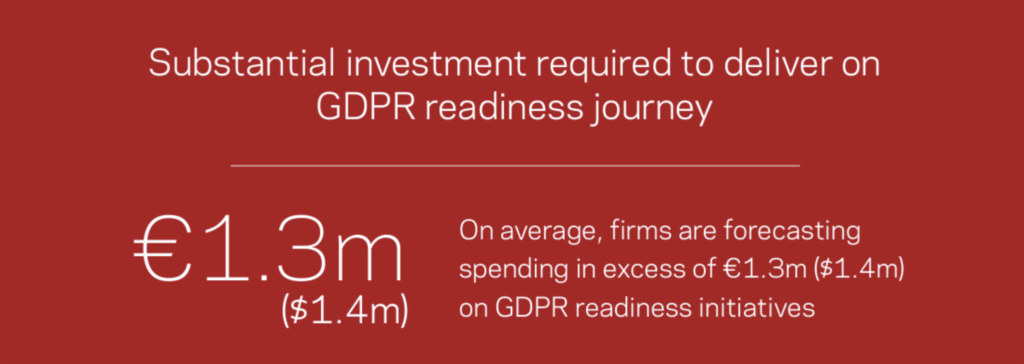
(Source)
Over 88% of companies were paying over £900,00 per year, and 40% of companies were paying more than £8,700,000 per year to comply with GDPR and collect similar quantities of consumer data. In addition to this, the costs of breaching GDPR or UK GDPR legislation can cost up to £17,500,000 or 12% of the firm’s yearly turnover.
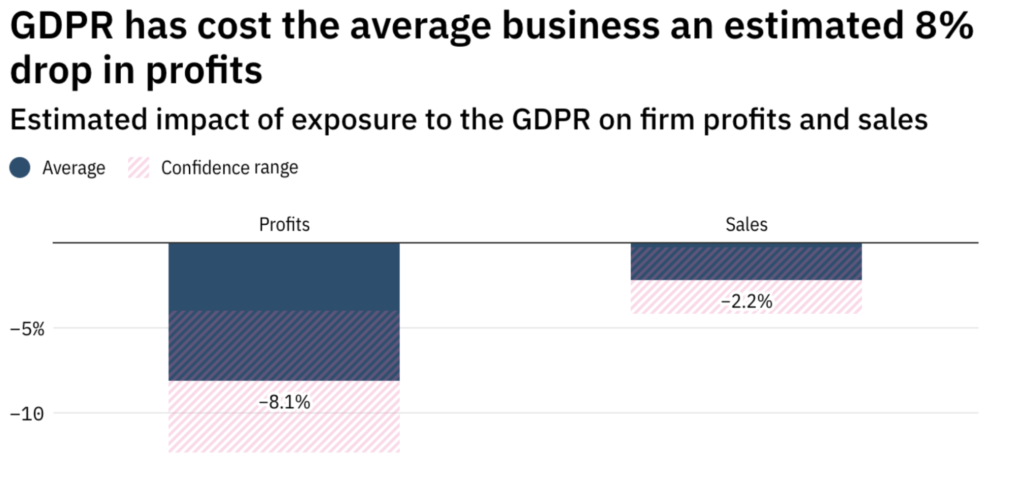
(Source)
To put it into a different perspective firms on average are losing up to 8% on their profits due to the rising costs of marketing. In a world where third-party cookies are dying off, and considering rising costs it is now more crucial than ever to ensure adequate utilisation of your own first-party data sources to help fuel successful marketing
IOS & Smartphones
Smartphones have become one of the primary mediums that marketing is consumed through nowadays. Similarly to laptops and desktops, smartphones have previously harnessed third-party data. Smartphone apps collect data by assessing watch times, patterns, peer usage (recommending content based on what your most texted peers consume) and even through location tracking. However, the GDPR legislation ensured that this level of privacy invasion would be challenged.
Third-party cookies have been on the decline for years, with Google and Apple deciding it is time to end the use of third-party cookies altogether. Demanding privacy, transparency and choice over their own data is something Google began to preach in recent years. Justin Schuh, Google's director of Chrome engineering is looking to change the way google approaches consumer privacy by pushing the elimination of third-party cookies. 2022 is set to be the year that Google’s own internet browser app Chrome is going to phase out the use of third-party cookies.
Where does Automated Direct Mail play a role?
With all the impacts and changes brought about by the introduction of the GDPR, direct mail has been presented with an incredible opportunity to become strategically significant again.
Automated direct mail marketing demonstrates anything but a lack of creativity. Sending a personalised message and offer to a consumer's front door is something special. Giving them a personalised offer landing in their home still effectively utilises data in a complicit way (customers do not have to opt into postal marketing to receive) It also makes the individuals feel like they are receiving relevant and personalised content.
1st-party cookies
Paperplanes only utilises first-party data for the creation of successful direct mail marketing campaigns.
Consumers whose data shows important behaviour such as the fact they haven’t made a repeat or second purchase will receive a campaign tailored to create more value from these consumers. Consumers who left their virtual basket full will receive a follow-up on their abandoned basket. Even those consumers who haven’t been to the e-commerce website in an extended period of time could be targeted again through Paperplanes Automated Direct Mail.
Paperplanes Solutions
Paperplanes direct mail solutions offer marketers the option to put their reliance on third-party cookies in the past.
Paperplanes solutions have helped several businesses rejuvenate their marketing and achieve great results such as:
- Website Returns
-
-
- 300% More likely to return
- 20% immediately went to the website
-
- Time spent browsing
-
-
- 50% more time spent browsing pages
-
- ROAS
-
-
- ROAS of £11 for every £1
-
- ROI
-
-
- £15 ROI for every £1 invested
- 7 times stronger than initial
-
- Topline Conversion
-
-
- 9.3% Topline conversion
-
- Abandoned basket conversions
-
-
- 40% Stronger with mail
- 9.3% of Baskets recovered
-
- Winback performance
-
- 12% of Lost customers were re-won
To learn more about Paperplanes and talk to our CEO please fill in the form at the bottom of your screen.
Sources
https://thinksmartmarketing.com.au/analytical-vs-creative-marketing-the-balance-for-driving-growth/
https://www.itgovernance.eu/blog/en/how-much-does-gdpr-compliance-cost-in-2020
The Folio Society Abandoned Basket Recovery | 26.7% conversion from customers mailed Abandoned
The Folio Society: Next best purchase
Context
Since 1947 Folio has been producing beautiful editions of the world’s best literature right in the heart of the creative quarter of London. With every book being a labour of love from a wonderful team of editors, designers and artists, each is a work of art. Folio publishes books that have changed the world, books that make us laugh, books that teach and books that blow your mind. Folio is an award-winning, employee-owned, independent publisher that delivers illustrated books to a dedicated band of readers around the world.
Action
Folio are partnering with Paperplanes to run a pilot activity for programmatic direct mail. The test is focused on triggering relevant, personalised, physical media to customers who have previously purchased in a 12-month period from the Folio website but have not visited since. We have also run activities to target customers who have recently placed an order or abandoned a cart to encourage a follow-up purchase or convert their basket. Consumers who left abandoned baskets are sent follow-ups to complete their purchase. Consumers who haven’t returned in a long time are sent ’win-back’ direct mail convincing them to return and make a purchase. Lastly ‘next best purchase’ mailing, focuses on following up with consumers after a recent purchase to suggest related products. The overarching goal is to see an increase in customer engagement online and to increase overall conversions.

Result
- 1 in 5 Customers are returning to Folio after receiving direct mail marketing

- The campaign successfully created a 26.7% conversion in sales from customers mailed Abandon and a 12.7% conversion from next purchase opportunities. Winback recovered 4.9% of the audience
- Mailed customers view 50% more pages and stay 40% longer than non-mail counterparts
- Early evidence of repeat purchase propensity with 21% of all targeted customers making more than one extra purchase since mailing.
Testimonial
‘With only a frustratingly low email opt-in rate, Folio has been looking for more ways to communicate with our customers at the point of abandon basket and post-purchase. Paperplanes offer an affordable and effective solution which is allowing us to contact customers in a timely manner with personalised, relevant content. This is helping us to recover potentially lost sales and add incremental revenue to our annual budget. Paperplanes have been great to work with from the get-go and we’re already seeing the benefits of our investment.’
Head of Marketing, Folio
Adapting your marketing with Direct Mail for 2023
How is marketing going to be affected heading into 2023?
Every year is a new opportunity to redevelop and re-think your marketing strategy. 2023 looks to be an interesting year where marketing will have to adapt to the global environment. The economic recession is predicted to last until the second two-quarters of 2023, energy and gas is in turmoil and the costs of email and digital marketing are also increasing. 2023 is going to be a challenge for marketers to make the most of their fluctuating budgets whilst having to navigate through the given circumstances. This blog will look into the UK economy outlook and suggest the best marketing investments for this uncertain era.
New Year, New Recession
From July until September 2022 the UK’s economy shrank by 0.2%. If this trend continues and Q4 of 2022 also results in a shrink in the economy then the recession for 2023 will be official. The bank of England has predicted that 2022 will end with another quarter in recession and 2023, as well as the first half of 2024, will all be months in which the economy will continue to shrink. The BBC has also noted that the UK is bottom of the G7 for economic growth.
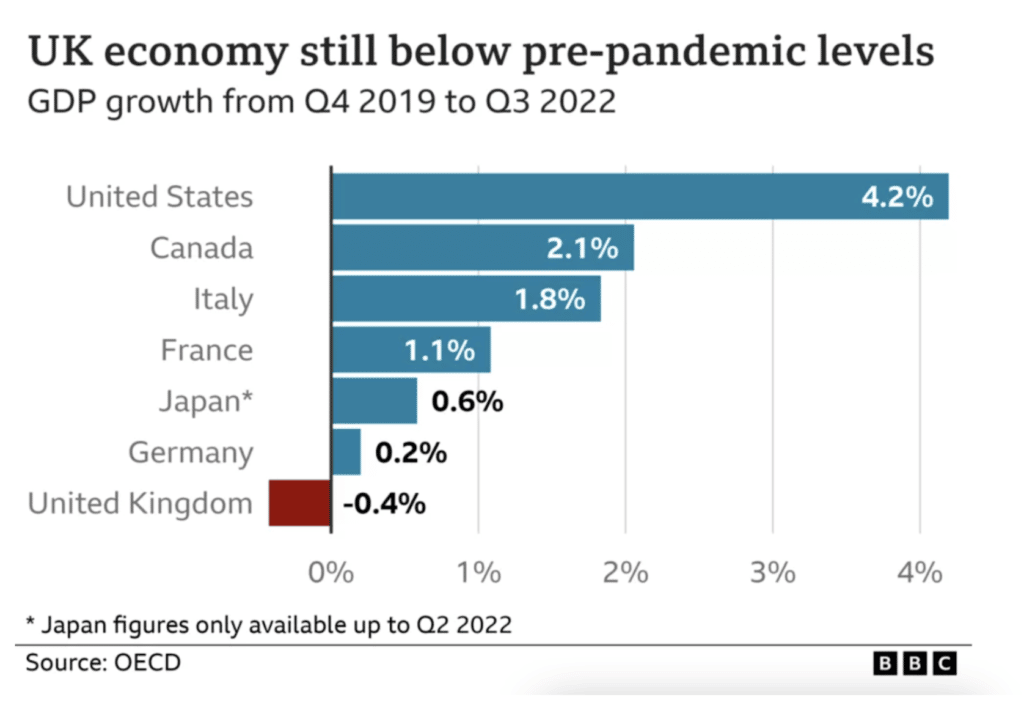
The IMF has recorded inflation rates that are higher than they have been in past decades as well as an unexpectedly sharp slowdown in economic activity. It is believed that the two main factors contributing to this economic slowdown are the lingering effects of the pandemic and the ongoing war in Ukraine. The ongoing conflict has led to increased gas prices across the UK due to a dependency on imported energy.
Importantly an economic recession will mean that global consumers will not be spending as much as they are used to. Businesses might need to adapt and begin cutting costs. On paper, this would sound worrying to marketers across the globe, as marketing budgets are often among the first few budgets to be slashed.
(Source)
Costs of Marketing
Despite the fact that marketing budgets are usually prone to be cut, less than 29% of multinational companies in the WFA (world federation of advertisers) are going to be spending less on marketing. These large organisations are committed to their brands and will continue with their planned spending. Over-investing at the bottom of the sales funnel during an economic recession could have long-term consequences. Inefficient spending and high acquisition costs over a sustained period of time are the opposite of what most marketers are looking to achieve. If companies plan on spending the same amount on marketing in 2023 as they did in 2022 prices for digital ad space will only continue to rise. Firms competing over digital ad space and topping their consumer's email inboxes will have to compete with each other by continuing to spend more.
Digital Mail
E-mail marketing is still considered to be one of the most cost-effective marketing methods and will continue to be popular with marketers in 2023. Demand for digital marketing and specifically e-mail marketing is continuing to grow due to its affordability and effectiveness, with 66% of small businesses relying on email marketing (Marketsplash, 2022). As more and more businesses continue to adopt email marketing the conversion rates are surely going to drop. Combining decreased consumer spending due to an economic recession with more businesses leaning heavily on email marketing could lead to a decline in conversion rates due to the competition.
Despite this several statistics still suggest that e-mail marketing has been effective over 2022:
- 63% of businesses reduce the frequency of emails sent to subscribers based on their levels of engagement. (Databox, 2022)
- 77% of marketers have seen an increase in email engagement over the last 12 months. (Not Another State of Marketing, 2021)
- 43% of marketers are changing how they measure email performance because of Apple’s Mail Privacy Protection, and 24% aren’t making any changes for now. (Litmus, 2021)
(Source)
Split in spends
In 2021 and 2022 trends suggested that digital marketing would take up 70% of average marketing budgets. However, as 2023 approaches the split between online and offline marketing has shifted towards equality. With 56% of marketing being online.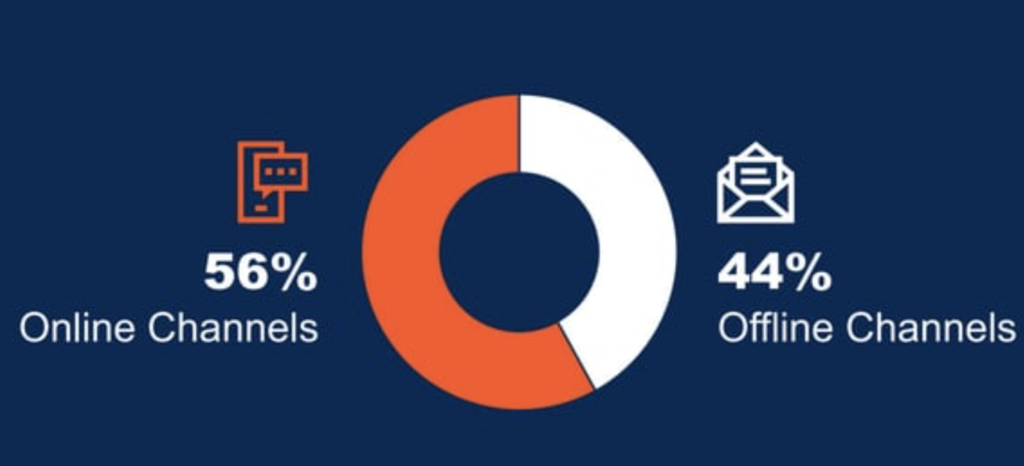
Out of this online marketing spend ⅔ of that spend goes towards paid ads across different social media and digital mediums. This is suggesting that onlineX marketing could become more expensive with more spending going to online ad space, and competitors could potentially drive prices to an unreasonable amount. An additional conclusion that the split in marketing spending brings forward is that offline marketing is making a comeback. Through direct mail marketing, channel marketers have a solution with a cost-efficient and highly effective marketing tool in programmatic direct mail.
(Source)
What about Programmatic direct mail (PDM)?
Programmatic direct mail is an excellent marketing tool to cost-effectively retain consumers and get a high return on investment. Using the best aspects of digital retargeting (data) in combination with the strengths of tactile marketing (personalised letters) creates a perfect blend of cost-effective marketing and scale. Achieve more by spending less is the first thing that comes to mind when trying to be cost-effective in marketing. PDM will always reach consumers at a relevant point in time so as to not overwhelm the consumer and spend unnecessarily on marketing which won’t have effective conversion rates. Mail that lands in the inbox at the right time will have higher uptake as seen by Paperplanes clients every day:
- Soak&Sleep
- 17.1% conversion in sales from customers mailed abandon
- Allplants
-
- The reactivation campaign had a 9% topline conversion rate for mailed customers
- Yougarden
-
- 17% of customers mailed went on to make a first conversion
Programmatic direct mail relies on less volume of marketing to consumers making it cheaper than regular direct mail marketing. At the same time, PDM has higher conversion rates making it an excellent contender to be part of any marketing strategy in 2023.
Conclusion
Despite the economic state changing, and the global economy going into a recession, marketing efforts need to continue. Marketers should consider focusing on customer retention and cost-effective methods of acquisition. Combining digital mail marketing and PDM for a cost-effective retention and acquisition strategy.
Sources
https://www.marketingprofs.com/charts/2022/47857/global-ad-spend-forecast-for-2023.
https://www.bbc.co.uk/news/business-52986863
https://marketsplash.com/email-marketing-trends/
https://www.webstrategiesinc.com/blog/how-much-budget-for-online-marketing
Conscious Marketing (The Importance of honesty and transparency)
Conscious Marketing - Value in shared customer goals & ease of opting out
With increasing competition within the digital marketing space, marketing has run through various transitions over the years, each affecting your business differently. Not all of it is great. Paying for fake followers or engaging with bots can bring you some business in the short term, but will likely damage brand reputation in the long run. Adapting sustainable and transparent approaches on the other hand can bring positive outcomes.
Conscious marketing is all about making ethical choices within your business operations and promoting customer priority and power at the forefront of marketing, maximising their satisfaction and urging them to make the best purchases for their own well-being. Rather than focusing on revenue and profits this style of marketing places ethics at its heart.
Conscious marketing can be linked with the values of a company and the ways in which they operate. Being conscious of its social responsibility, being transparent with its shareholders and customers and showing support to the local community whilst also demonstrating diversity and inclusion; making the world a better place than it was before the company’s existence. Most importantly, giving your customers the true sense of being a part of a grand positive movement within your brand.
The philosophy of conscious marketing is built on the belief that transparency and customer satisfaction will lead to lower marketing costs in the long run and increased loyalty amongst customers. According to HubSpot, conscious marketing campaigns have a higher customer-brand reputation, increased loyalty and are more likely to convert. Typical email marketing campaigns tend to have a 0.6% conversion average, whilst conscious email campaigns can increase performance by 10%!
Conscious marketing doesn’t have limitations and can yield even better results by respecting client data, communication choices, and making it overall a great experience for them.
Receiving an email with an offer from a brand you like can be great, but imagine receiving a personalised, tangible letter addressed to you, with a discount on the products you like, and contributions going to a charity or to offset the carbon footprint you're creating?
Paperplanes programmatic direct mail does just that - it personalises and suggests the next best purchase for each customer that is mailed. This is both conscious in that it uses data to eliminate waste and determine the best choice for the customer to make as well as being effective. Take for example next best purchase campaigns converting up to 30% of mailed customers, far beyond the capabilities of its digital and physical counterparts.
CSR
Modern corporate social responsibility (CSR) is a “self-regulating business model that helps a company be socially accountable to itself, its stakeholders and the public. Companies can be conscious of the impact they are having on all aspects of society, including social, economic and environmental. CSR allows companies to develop in their business and equally contribute positively to its society and all parties involved ‘(Investopedia,2022). Looking into ways that enhance rather than degrade the environment helps provide a better brand image by default as well as raise morale in the workplace.
Giving your customers a shared vision of sustainability will strengthen your bond with your consumers and as a result will boost organic SEO, acquisition and retention strategies.
To read more on sustainability in direct mail marketing read our dedicated blog: https://paperplanes.co.uk/programmatic-direct-mail-environmentally-positive-marketing/
At Paperplanes, CSR is something we take seriously, and our mission is geared around reducing waste through the efficient use of data and always ensuring we are accountable for our impact on the environment. For example, Paperplanes partners with TeamTrees to help minimise our carbon footprint on the planet. By replanting trees to replace the sheets of paper we use to mail our customers, we are taking accountability for our overall impact on the world and its valuable resources.
Typically the effects of CSR will have a smaller impact on sales and revenues as time passes. Consumers will get used to and expect a certain level of social responsibility from an organisation, however, this only means that the level of CSR has to be increased by the organisation.
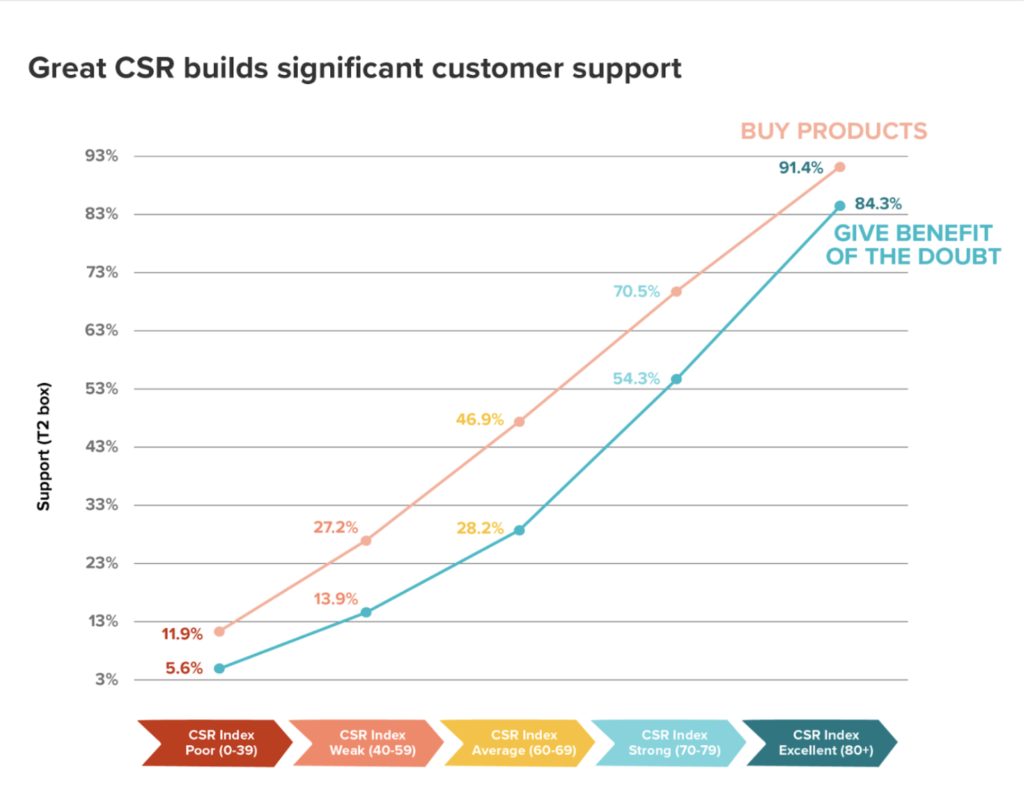
(Perry P. ,2020)
Transparency
When marketing with a conscious strategy a firm would benefit from being transparent with its processes, data, and operations; making its actions clear and observable to its shareholders and the public who might be reading news or updates on the said firm.
Though there are many reasons to be transparent across operations and departments, transparency is more important for a company's marketing function. A firm’s marketing strategy could be made more effective with greater transparency. Building consumer trust could lead to consumers becoming more responsive to marketing via social media, TV marketing and direct mail build brand equity..
What makes this approach conscious? Ensuring the above will increase consumer trust and satisfaction with the company’s services or products, leading to an overall stronger marketing campaign.
Support community/customer satisfaction
The conscious marketing concept and strategy positively impact customer satisfaction, especially when customers are put at the forefront of the mission.
Conscious marketing should take into consideration customer preferences. Since the GDPR regulations came into force in 2018, over 40% of customers have opted out of direct marketing in the UK, according to Deloitte. This makes it clear that many do not find the marketing pieces directed towards them of any value. This percentage is gradually increasing over the years, as more data restrictions come into play, and more ‘spam’ is flooding consumers inboxes. Allowing for ease to opt out of your marketing, whether it’s physical or digital, will give customers the sense that your material and brand are valuable. No one likes to have to click through multiple links and buttons or send back letters to opt-out.
A simple opt-out process is a welcome step towards responsible and conscious marketing, giving subscribers power and alleviates marketers from blame through their own choice.
A potential way to make customers more satisfied is through Paperplanes utilisation of first-party data to drive increased relevance and efficiency in selecting a customer universe for mail. At Paperplanes we provide your consumers with a personalised marketing experience as well as perfectly timed offers. By not overwhelming consumers with spam through physical or digital mail firm’s can build a higher level of customer trust and improve the perception of the business. Personalisation is key! Businesses should not simply send all its consumers the same offers at a high frequency but rather make a conscious effort to genuinely improve a customer's experience.
Get in touch to learn more about optimising your marketing budget and simultaneously partaking on a CRS journey that will benefit your brand, your profits and your soul equally!
Sources
https://blog.submittable.com/corporate-social-responsibility-csr/
Sustainability in Modern Marketing
How suitable is Digital & Direct Mail advertising for today’s savvy marketers?
Digital Marketing has evolved rapidly over the past years, so much so that oversaturation of social media channels has created an inefficient marketing investment for most businesses. Surprisingly in the UK, only 60% of businesses use paid social media advertising in 2022 (Office for national statistics, 2022). With a recession well on the way on top of an already expensive and competitive space, Marketers are now allocating budget into creative new channels that can provide a higher return on investment with higher CTR and CPA.
It’s important to understand that social media marketing has low engagement rates across the board. Hootsuite has estimated that the average social media post engagement rate is between 1% to 5% with Hootsuite personally measuring their own engagements at 4.5%. On the other hand, direct mail marketing in 2021 had a 9% response rate which is a metric that is more impressive. Online engagement can be considered as ‘likes’ and ‘comments’ which doesn’t always mean an actual purchase will be made, direct mail engagement will almost always lead to a purchase.
Digital marketing can be very expensive. Growing an organic audience is difficult and it would take months or even years to accumulate a large audience without paid adverts. Programmes such as LinkedIn sales navigator and Facebook ads are almost always required to boost efforts. Not to mention google keywords costs can add up very quickly based on clicks and traffic i. With an average 2.35%, conversion rate Google marketing and social media marketing could prove costly without amazing returns to back up the investments.
E-Mail marketing is a foundation of all businesses to allow for ease of communication at a relatively low cost compared to other digital formats. And although the use of email is consistently on a rise, digital fatigue has unfortunately also caused this medium to dwindle in response (<1%)
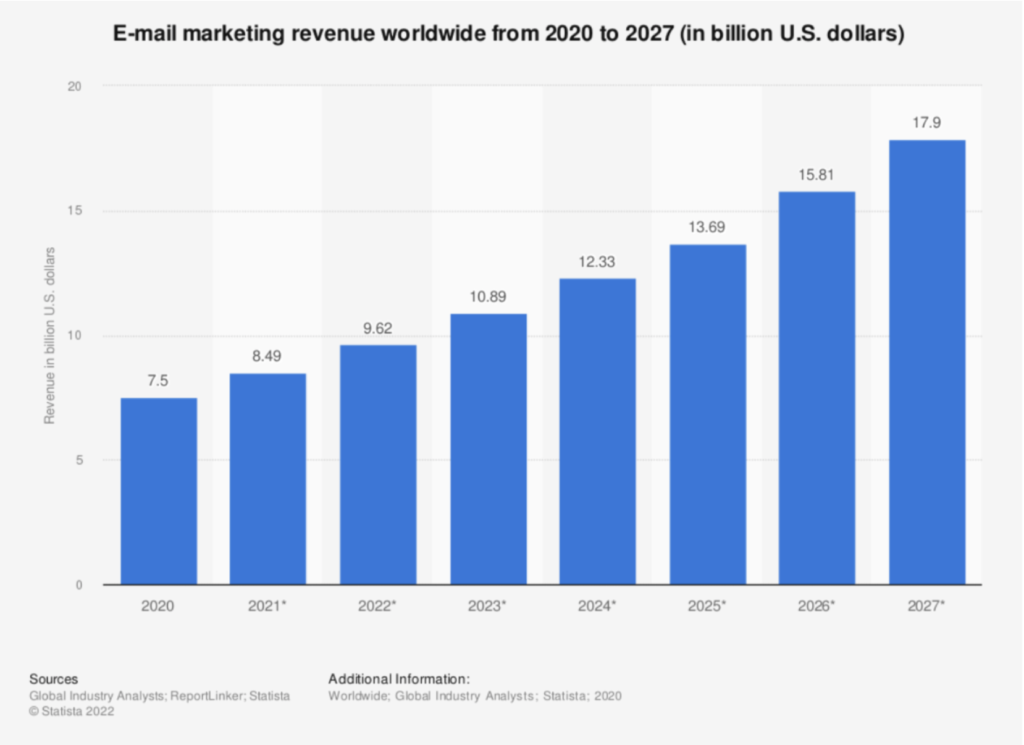
Pain points
Social media platforms have billions of users on them with facebook having just over 2.9 billion users. Social media as a marketing platform has huge potential with over 84% of people aged 18-29 using some form. At the same time, this young generation is using social media to get more information on brands before making online purchases suggesting social media marketing would have good conversions and engagement rates.
However social media marketing poses challenges. It may be ineffective for many marketers due to changing algorithms that each social media platform uses, the frequency at which these algorithms vary and the favouritism that social media platforms have towards certain content. Platforms such as TikTok rely on post engagement and ‘watch time’ to recommend different content. Posting frequently on such a platform rewards the business for having their ads pop up more often in the algorithm. On the other hand media such as Instagram don’t reward frequent posting anymore. Noticing a business account is posting too frequently will push its content further down the funnel and make it less visible to users.
Getting engagement with social media is another pain point that can often come with social media. Creating content which is more engaging, gripping or being able to tell a story through social media marketing is difficult. This content is difficult to create as attention spans have decreased on social media. Studies suggest that the average user has an 8-second attention span across popular social media platforms. This leaves the marketer with the huge task of designing and taking the monetary risk by creating content which they believe can be gripping enough to share or like whilst keeping it digestible within a few seconds.
Conversion rate standards across social media suggest that having a 3% conversion rate on paid social media ads is a very good turnout for B2C and B2B content. This conversion rate may be disappointing to many marketers especially when direct mail in the UK was close to a 5% conversion rate on exclusively B2C marketing (and Paperplanes average 14%!). Making social media marketing less of an attractive option to certain marketing teams, and possibly less desirable to business selling products with small profit margins that won’t cover the costs of social media marketing.
And lastly, there are issues revolving around the use of 3rd party cookies, data storage and data storage legislation which can interfere with retargeting systems developed in recent years.
Direct mail
The tangible, physical component of a piece of marketing content has psychological attributes that will forever remain unmatched by digital marketing. Being able to read and digest the content at your own convenience is a huge bonus. No stress salesman on the phone, no 5-second click window ad banner or social media post before the feed/page refreshes. The content stays at home - no rush and the recipient will likely go back and look at it a few times, acting as a constant reminder of your brand.
Thanks to the aforementioned over-utilisation of digital retargeting, customers are paying less attention to the many promotional ‘spam’ emails or ads, and are quite happy to open up and read a real-world letter addressed personally to them. The tactile and personally addressed factors also act on the human senses, strengthening the relationship with customers and having them more engaged with your brand,
The issue with direct mail in the modern era is the lack of data, which causes a poor outlook for the future sustainability of this channel compared to its digital counterparts. Although data privacy here is not problematic, marketing campaigns have to use a cookie-cutter one-size-fits-all campaign approach and send large volumes. Each mailing piece is far more expensive than an email, but the conversion and response rates are far greater, sitting at an average of 10%.
Programmatic Direct Mail
Luckily there is a new channel with a bright sustainable outlook which takes the best of both digital and direct mail marketing and cuts out all the mentioned roadblocks.
Programmatic Direct Mail (PDM) uses only first-party cookie data from your website to automatically generate hyper-personalised letters with content and promotions relevant to each individual, sent in the form of a physical letter shortly after your engagement online.
This is exactly what we do at Paperplanes, hitting better targets than mass direct mail campaigns with up to 80% less volume, and attain 30% conversion rates and response rates.
The cost per acquisition is up to 5x lower than social media or email and creates an incredible experience for customers.
Get in touch to learn how a Paperplanes intelligent direct mail campaign may look for your business.
Sources


